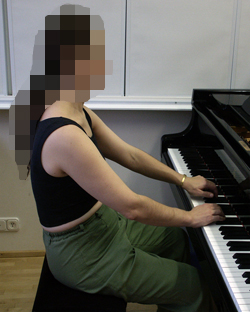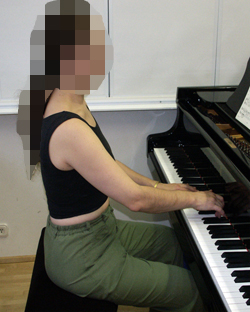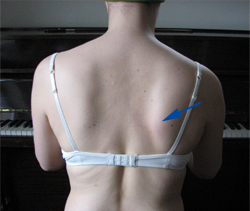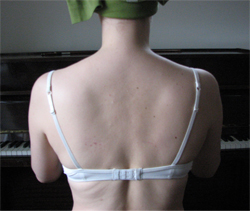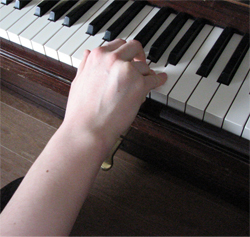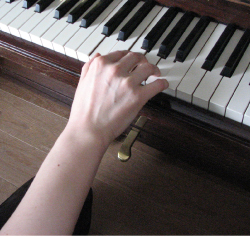Piano - harjoittelu
Piano
Lue Yleistä ergonomiasta ensin.
Kehon keskiasento on soittajan perusasento, johon hän aina palaa. Keskiasennossa selkärangan luonnolliset kaarirakenteet säilyvät. Selkärangan kaarien muodot ovat yksilölliset, joten kaikkien selkä ja lantio eivät näytä samalta keskiasennossa.
Pianonsoittajasta tulee ensin tarkastella lantion asentoa. Lantio viedään keskiasentoon jossa lantion istuinluut osoittavat suoraan kohti jakkaraa/tuolia.
|
Lantio kallistuneena taaksepäin, selkäranka pyöristyneenä, lapaluut kallistuvat eteenpäin rintakehän mukana. |
Lantio ja selkäranka keskiasennossa, lapaluut pystyasennossa rintakehää vasten. |
Tuolikorkeus tulee säätää sellaiseksi että keskiasennon ylläpito tulee olla luontevaa. Rakenteeltaan jäykempi henkilö tulee istua korkeammalla kuin notkeampi henkilö, lisäksi jakkaran korkeuden säätöön vaikutta pianon ja tangenttien korkeus. Pianon tulisi olla sellaisella korkeudella että kyynärnivelet ovat 90 -110 asteen kulmassa, jolloin ranne voidaan pitää 15 astetta ojennettuna. Kyynärvarren ja ranteen koukistuessa liian matala pianon takia, pianoa tulisi korottaa (ainakin kotioloissa!) tai sitten lonkka-lantionseutua tulisi venyttää ahkerasti, niin että pystyy istumaan, hyvässä asennossa, matalammalla jakkaralla. Pianojakkaran etäisyys koskettimista tulee olla sellainen että kyynärpäät jäävät reilusti vartalon sivulinjan etupuolelle.
Lantion-lannerangan ollessa keskiasennossa selkärangan keskiasennon hallinta on parhaimmillaan. Rintarangan yliojentamista esiintyy suhteellisen yleisesti pianonsoittajalla. Tämä johtunee joko lantion-lannerangan taaksepäin kallistuneesta asennosta ja/tai lapaluun tukilihasten huonosta hallinnasta tai perimästä (vaihtoehdoista epätavallisin). Lapaluun tukilihasten merkitys on suuri pianonsoitossa koska käsivarsia kannatellaan jatkuvasti. Lapaluun puuttuvan tukilihasten toiminnan seurauksena lapaluu siirtyy liikaa sivulle ja kallistuu eteenpäin(tämä estää lapaluun luonnollisen kiertymisen), isäksi lapaluu saattaa siivetä irti rintakehästä.
|
Lapaluut huonosti tuettuna rintakehää vasten ja lapaluut siipeävät irti rintakehästä, kallistuvat eteenpäin ja erityisesti oikean lapaluun alakulma kiertyy virheellisesti kohti selkärankaa. |
Lapaluut hyvin tuettuna rintakehää vasten. |
Lapaluun virheasento lisää niska hartiaseudun rasitusta, pienentää yläaukeamaa (solisluun, lapaluun ja rangan väliin jäävä alue, josta hermot ja verisuonet kulkevat käteen) sekä lisää rasitusta kyynärvarren lihaksissa. Kyynärvarsiongelmat ovat pianistilla yleisimpiä vaivoja ja syynä ylirasitustiloille ovat yleensä käden ja koko yläraajan puuttuva hallinta.
Ranteen perusasento tulisi olla 15 astetta ojennettuna ja 15 astetta pikkusormeen päin kallistuneena, tästä asennosta ranne joustaa soiton aikana. Asento mahdollistaa hyvän kämmenlihastoiminnan ja siten kämmenen poikittaiskaarirakenteiden säilymisen. Pianistin ranne- ja kyynärvarren kiputiloissa on useasti nähtävissä se, että ranteen ja kämmenen tukilihasten hallinta on puutteellinen ja että ranteen yli menevät, sormia liikuttavat lihakset, työskentelevät liikaa.
|
Ranne koukistuu ja kääntyy peukaloon päin. Sormien I, IV ja V tyvinivelet ovat löysät ja kämmenen poikittaiskaari ei säily soiton aikana. |
Ranne on keskiasennossa ja rystysten muodostama poikittaiskaari säilyy, jolloin sormien tyvinivelet ovat tuettuna ja sormiliike on vapaa. |
Korjatessa ranteen ja käden asentoa, soittaja tarvitsee tuekseen harjoitteita, jotka parantavat käden lihastasapainoa.

